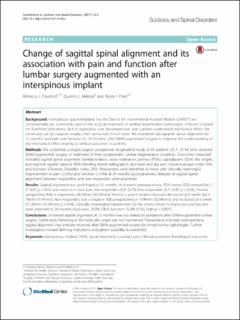Please use this identifier to cite or link to this item:
https://doi.org/10.21256/zhaw-4716| Publication type: | Article in scientific journal |
| Type of review: | Peer review (publication) |
| Title: | Change of sagittal spinal alignment and its association with pain and function after lumbar surgery augmented with an interspinous implant |
| Authors: | Crawford, Rebecca J. Malone, Quentin J. Price, Roger I. |
| DOI: | 10.21256/zhaw-4716 10.1186/s13013-017-0109-z |
| Published in: | Scoliosis and Spinal Disorders |
| Volume(Issue): | 12 |
| Issue: | 2 |
| Issue Date: | 2017 |
| Publisher / Ed. Institution: | BioMed Central |
| ISSN: | 2397-1789 |
| Language: | English |
| Subjects: | Clinical outcomes; DIAM; Interspinous implant; Low back pain; Radiological outcomes; Spinal alignment |
| Subject (DDC): | 617.5: Orthopaedic surgery |
| Abstract: | Background: Interspinous spacer/implants like the Device for Intervertebral Assisted Motion (DIAM™) are controversially yet commonly used in the surgical treatment of lumbar degenerative pathologies. Criticism is based on ill-defined indications, lack of superiority over decompression, and a poorly understood mechanical effect. Yet, continued use by surgeons implies their perceived clinical merit. We examined radiographic spinal alignment for 12 months, and pain and function for 24 months, after DIAM-augmented surgery to improve the understanding of the mechanical effect relating to clinical outcomes in patients. Methods: We undertook a single-surgeon prospective, longitudinal study of 40 patients (20 F, 20 M) who received DIAM-augmented surgery in treatment of their symptomatic lumbar degenerative condition. Outcomes measured included sagittal spinal alignment (lumbar lordosis, sacral inclination, primary (PDA), supradjacent (SDA) disc angles, and regional sagittal balance (RSB; standing lateral radiographs), and back and leg pain (visual analogue scale; VAS) and function (Oswestry Disability Index; ODI). Responders were identified as those with clinically meaningful improvement to pain (>20%) and function (>15%) at 24 months postoperatively; features of sagittal spinal alignment between responders and non-responders were examined. Results: Sagittal alignment was unchanged at 12 months. At 6 weeks postoperatively, PDA (mean (SD)) reduced by 2.2° (4.0°; p < 0.01) and more-so in back pain non-responders (3.8° (3.2°)) than responders (0.7° (4.4°); p < 0.05). Positive preoperative RSB in responders (26.7Rmm (42.3Rmm); Rmm is a system-relative measure) decreased at 6 weeks (by 3.1Rmm (9.1Rmm)). Non-responders had a negative RSB preoperatively (−1.0Rmm (32.0Rmm)) and increased at 6 weeks (11.2Rmm (15.5Rmm); p < 0.05). Clinically meaningful improvement for the whole cohort for back pain and function were observed to 24 months (back pain: 25.0% (28.0); function: 15.4% (17.6); both p < 0.0001). Conclusions: Unaltered sagittal alignment at 12 months was not related to symptoms after DIAM-augmented lumbar surgery. Subtle early flattening at the index disc angle was not maintained. Preoperative and early post-operative sagittal alignment may indicate response after DIAM-augmented surgery for mixed lumbar pathologies. Further investigation toward defining indications and patient suitability is warranted. |
| URI: | https://digitalcollection.zhaw.ch/handle/11475/11499 |
| Fulltext version: | Published version |
| License (according to publishing contract): | Licence according to publishing contract |
| Departement: | School of Health Sciences |
| Organisational Unit: | Institute of Public Health (IPH) |
| Appears in collections: | Publikationen Gesundheit |
Files in This Item:
| File | Description | Size | Format | |
|---|---|---|---|---|
| 2017_Crawford_Change_of_sagittal_spinal_alignment.pdf | 852.33 kB | Adobe PDF |  View/Open |
Show full item record
Crawford, R. J., Malone, Q. J., & Price, R. I. (2017). Change of sagittal spinal alignment and its association with pain and function after lumbar surgery augmented with an interspinous implant. Scoliosis and Spinal Disorders, 12(2). https://doi.org/10.21256/zhaw-4716
Crawford, R.J., Malone, Q.J. and Price, R.I. (2017) ‘Change of sagittal spinal alignment and its association with pain and function after lumbar surgery augmented with an interspinous implant’, Scoliosis and Spinal Disorders, 12(2). Available at: https://doi.org/10.21256/zhaw-4716.
R. J. Crawford, Q. J. Malone, and R. I. Price, “Change of sagittal spinal alignment and its association with pain and function after lumbar surgery augmented with an interspinous implant,” Scoliosis and Spinal Disorders, vol. 12, no. 2, 2017, doi: 10.21256/zhaw-4716.
CRAWFORD, Rebecca J., Quentin J. MALONE und Roger I. PRICE, 2017. Change of sagittal spinal alignment and its association with pain and function after lumbar surgery augmented with an interspinous implant. Scoliosis and Spinal Disorders. 2017. Bd. 12, Nr. 2. DOI 10.21256/zhaw-4716
Crawford, Rebecca J., Quentin J. Malone, and Roger I. Price. 2017. “Change of Sagittal Spinal Alignment and Its Association with Pain and Function after Lumbar Surgery Augmented with an Interspinous Implant.” Scoliosis and Spinal Disorders 12 (2). https://doi.org/10.21256/zhaw-4716.
Crawford, Rebecca J., et al. “Change of Sagittal Spinal Alignment and Its Association with Pain and Function after Lumbar Surgery Augmented with an Interspinous Implant.” Scoliosis and Spinal Disorders, vol. 12, no. 2, 2017, https://doi.org/10.21256/zhaw-4716.
Items in DSpace are protected by copyright, with all rights reserved, unless otherwise indicated.